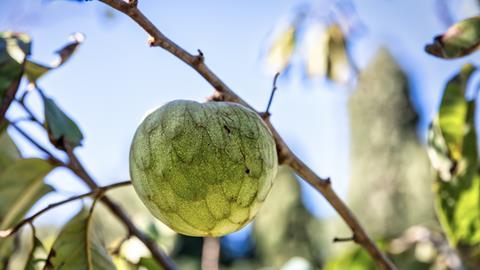Researchers identify numerous ‘forgotten’ fruit and veg that could support food security in future
The wild custard apple is one of a number of “forgotten food crops” identified as being potentially instrumental in adapting future food systems to climate change.
Researchers at Scotland’s Rural College (SRUC), the World Vegetable Center, World Agroforestry and partner institutions have modelled how nutrient-rich forgotten food crops – crops not promoted in recent decades with the dominance of major staples – could help diversify future food systems to make them more climate-resilient and healthier.
The research, published in Proceedings of the National Academy of Sciences of the USA, considered the case of sub-Saharan Africa, where the need to support food and nutritional security is high and where there any many potential forgotten food crops that could be more widely grown. Like elsewhere in the world, Africa’s climate is getting hotter, and weather events like floods and droughts are increasing, and this means that agriculture must adapt.
Climate niche modelling was used to prioritise 58 forgotten food crops from seven different food groups including fruits, leafy vegetables, pulses and cereals that have the highest potential to contribute to healthy climate-proof cropping systems of the African major staples of maize, rice, cassava and yams to the year 2070.
Dr Ian Dawson, a reader at SRUC, explained: “Africa already has massive problems in achieving sufficient nutritious food supply, and climate change is expected to make the situation a lot worse. Colleagues at the World Vegetable Center and World Agroforestry are committed to supporting the diversification of Africa’s food systems with a range of healthy foods.”
Lead author Maarten van Zonneveld from the World Vegetable Center said: “Of the 58 prioritised forgotten food crops, many are annuals and tree fruits rich in Vitamin A and C, and a large number are vegetables high in Vitamin A, iron, folate and zinc. Our study shows that in most locations where major staples are currently grown in sub-Saharan Africa, one or more forgotten food crops from the different food groups will be suitable for cultivation under 2070 climate conditions and can diversify major staples to support more nutrient-rich diets.”
Dawson added: “Although our paper looks at future food systems for Africa, there is no reason why similar climate-niche modelling methods should not be applied to forgotten foods in other parts of the world, and that includes Europe and the UK. Already, the UK is thinking about how to introduce or reintroduce unusual legume, cereal and vegetable crops into production, to reduced greenhouse gas emissions by providing alternative sources of protein to meat, and to create healthier diets. So these moves would also help adapt our food system to the future climate we anticipate.
“The special thing about our current research was that we not only modelled crop distributions, but we looked at the nutritional value of the crops and therefore more directly how their production affects diets, which is a crucial factor in support of micronutrient supply ‘beyond calories’ that current staple crops provide. In the UK recently, we have seen the problems of getting access to healthful salad crops, for example.
“As we note in the paper, the climate modelling we have done is of course only an initial step in supporting food system diversification, and many other considerations are needed to design future food systems and put these designs into practice. We need to work with producers and consumers to find out what works in bringing about useful change, but our modelling is a useful step on the way.”




